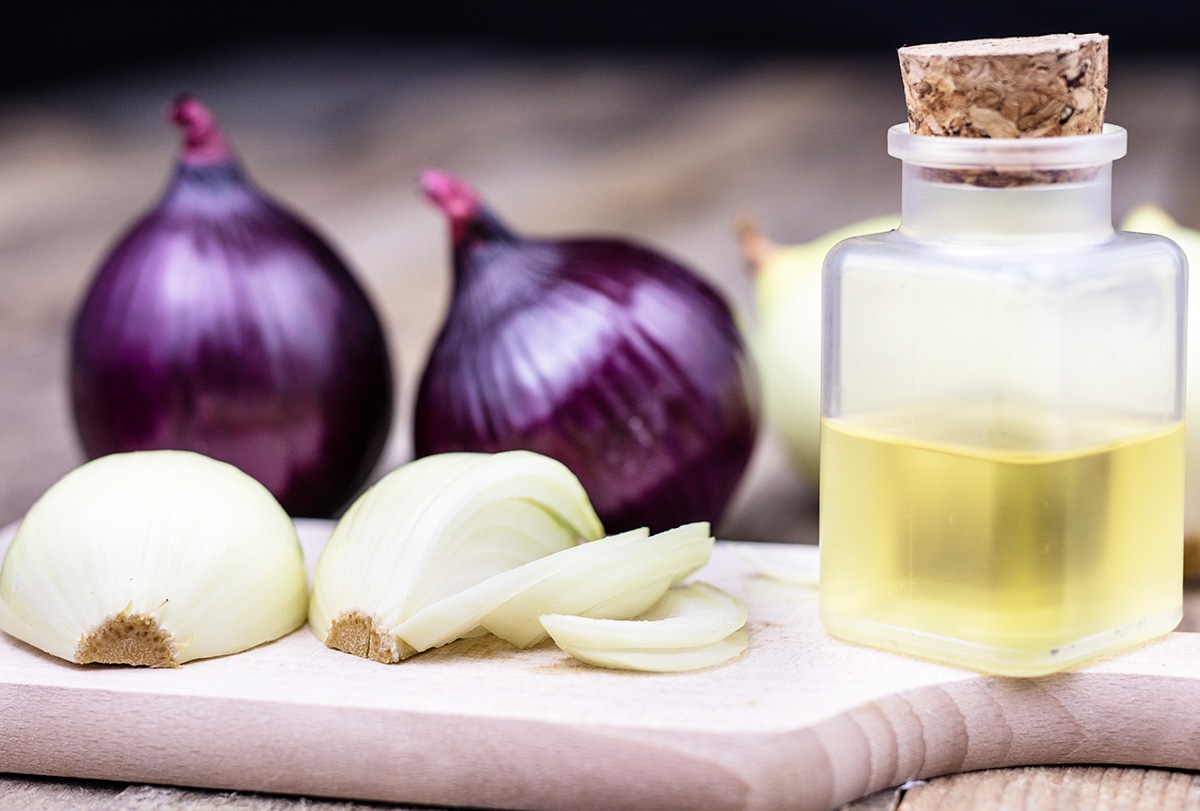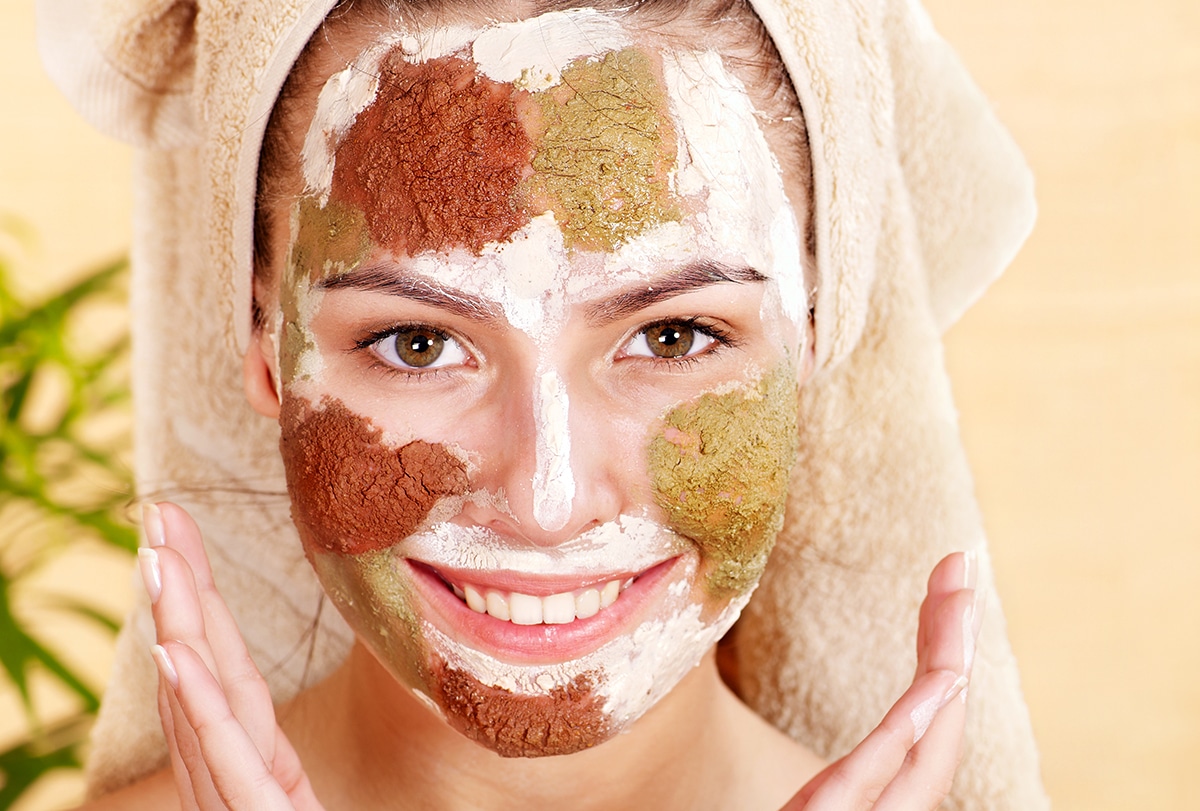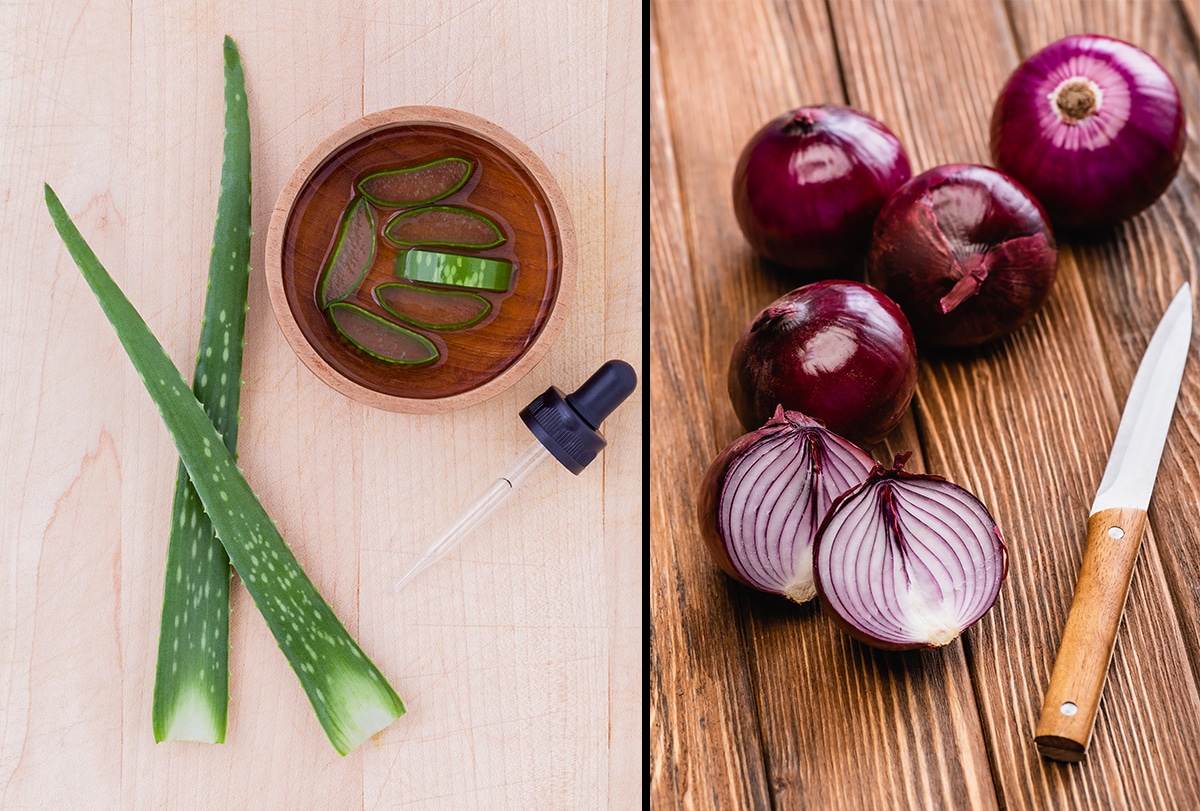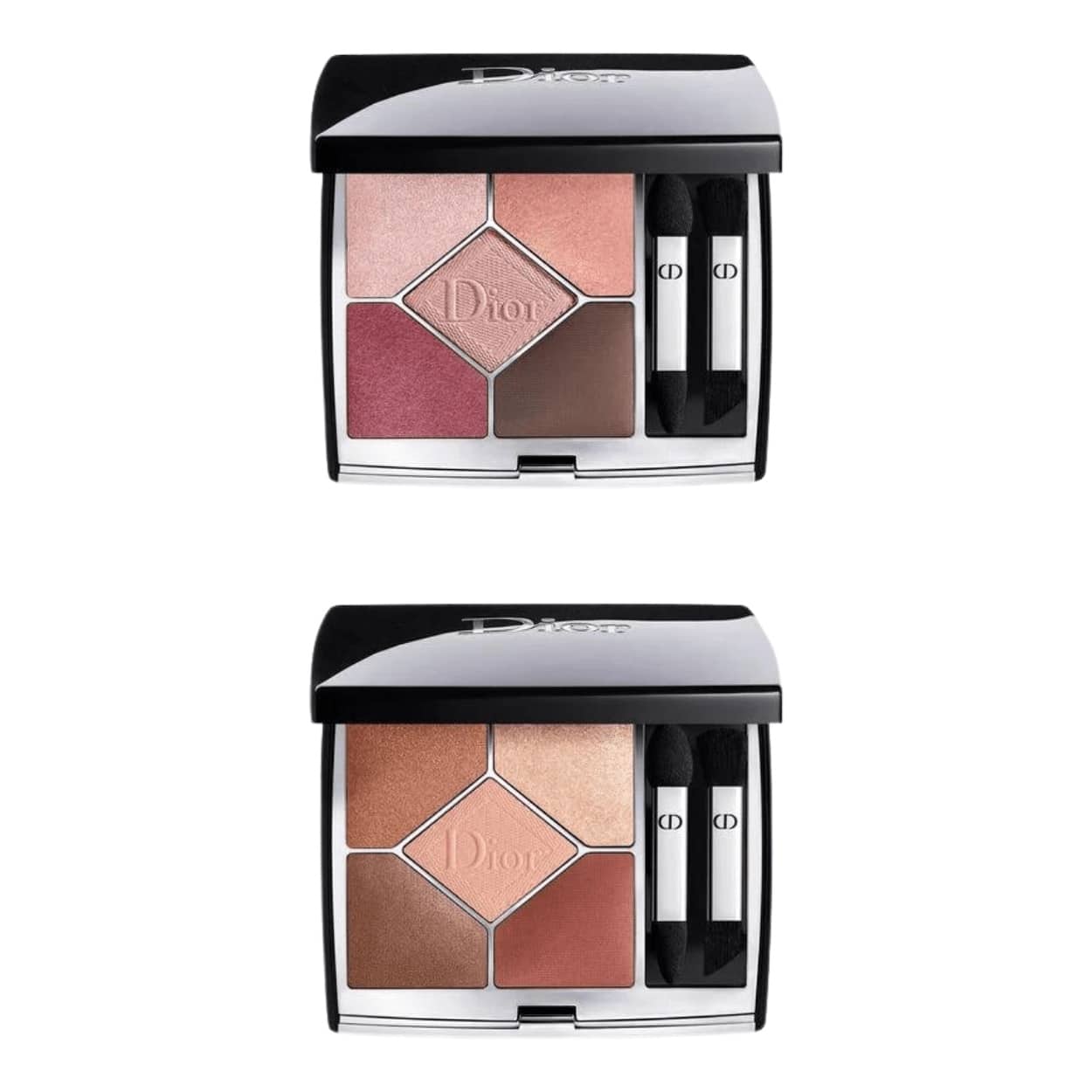The concept of a detox bath does not have a scientific origin and is mostly acknowledged as an anecdotal invention. However, the natural ingredients used in such a bath are credited with healing properties that can benefit the body in different ways.
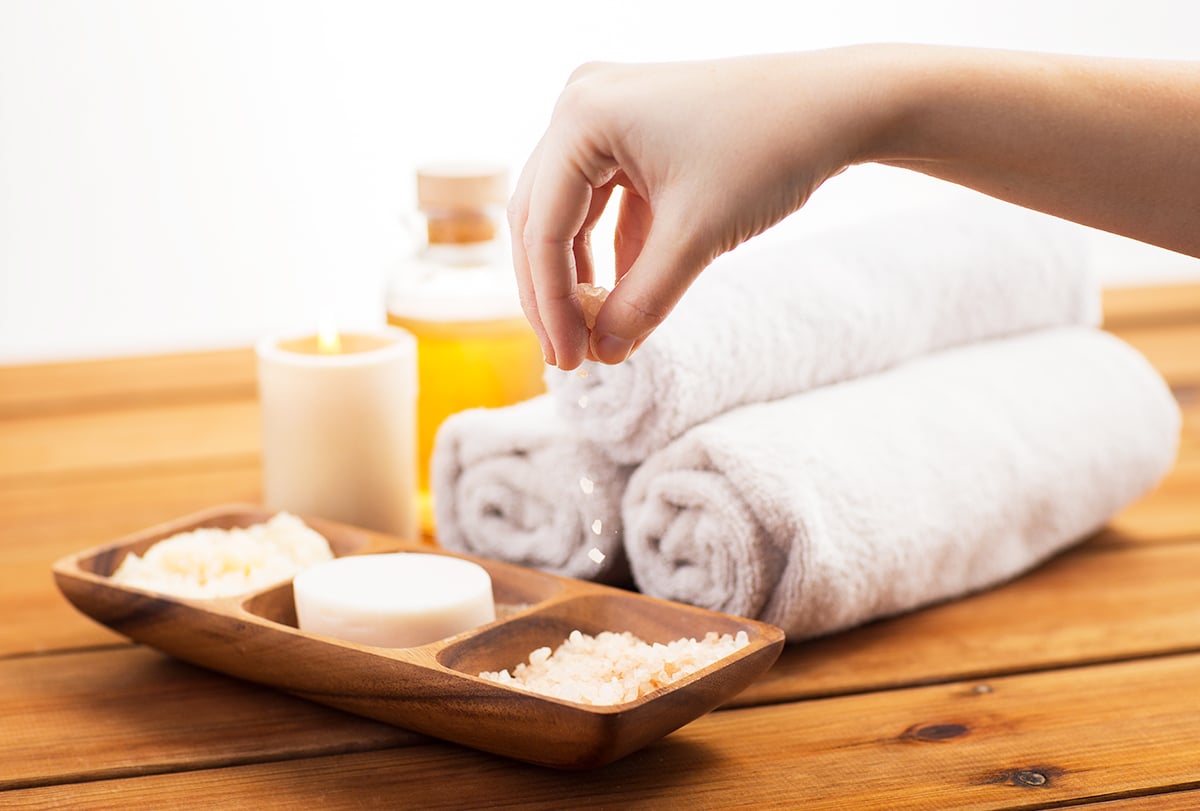
The main aim of detox baths is to eliminate harmful toxins and other impurities from the skin while restoring key minerals such as magnesium, potassium, and sulfates.
Detox Bath Recipes
You can easily fix yourself a detox bath at home with cheap and readily available ingredients. Here are a few popular ways to do that.
Disclaimer: Salt baths can overstimulate your circulatory system and put increased pressure on your heart and the entire body. This could be dangerous for people with a weak heart, poor blood circulation, hypertension, and other cardiovascular ailments as well as those dealing with other chronic illnesses such as diabetes and liver problems.
Pregnant women are also advised against trying this intervention unless approved by their ob-gyn. If you fall in any of these categories, always consult your doctor before trying a detox bath or any kind of salt bath. (1)
1. Basic salt detox bath recipe
Ingredients:
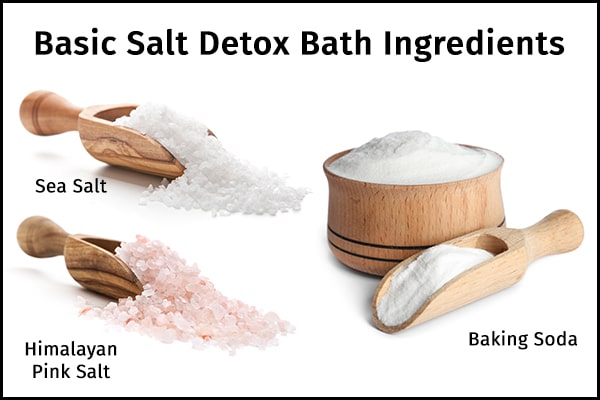
Instructions:
- Fill your bathtub with lukewarm water, which should be at or just above body temperature.
- Mix the sea salt or Himalayan pink salt and baking soda in the water until they are fully dissolved.
- You can also pour 3–4 drops of any soothing essential oil for added aroma, rejuvenation, and healing effects. Eucalyptus oil and lavender oil are good options, but don’t add too much as these potent oils can irritate your skin at high concentrations.
- Let your body soak in this bath for no more than 20–30 minutes.
Disclaimer: Baking soda can disrupt the normal pH of the skin and make it more alkaline; it can strip away its natural lipids and cause extreme skin dryness. So, be careful when using this ingredient topically. Conduct a patch test before application and don’t use it excessively. If you have sensitive skin, it’s best to skip it altogether.
2. Clay detox bath recipe
Ingredients:
- ½ cup bentonite clay (2)
- ½ cup Epsom salt (3)
Instructions:
- Put the Epsom salt in your lukewarm bathwater and mix until it dissolves.
- Add a few drops of your preferred essential oil to the bathwater (optional).
- There are two ways of incorporating bentonite clay into this bath:
- You can dissolve it separately in some water and then add it to the bathwater. Adding it directly to the bathwater can make it clump together.
- Make a smooth thick paste by mixing a little water into the clay and then rub it all over your body. Direct application will make it easier for the clay to pull out the toxins, dirt, and other grime from the skin. Wait for 5 minutes for the clay to dry before stepping into the bath.
- Immerse your body in the bath for at least 20 minutes, and use a washcloth to scrub the clay off the skin.
3. Ginger and Epsom salt detox
Ingredients:
- 1 cup Epsom salt
- 4 tbsp ground ginger (4)
Instructions:
- Put the Epsom salt and ground ginger in your lukewarm bathwater, and stir it with your hands so that all the ingredients are properly dissolved.
- Soak in this bath for at least 20 minutes.
- Once you step out of the bath, let your skin air-dry or dab it with a towel.
- Relax for about 30 minutes before showering.
Note: This detox bath is known to induce excessive sweating, which can lead to dehydration if you do it too often. So, limit it to once or twice a week.
4. Oxygen detox bath recipe
Ingredients:
- 2 cups hydrogen peroxide
- 1 tbsp dried ground ginger
Instructions:
- Fill your bathtub with lukewarm water.
- Add the hydrogen peroxide and dried ginger, and give it a good stir so that everything blends together.
- Soak in the bath for 30 minutes.
5. Bentonite clay and activated charcoal bath bomb
Ingredients:
- 2 cups Epsom salt
- 1 cup bentonite clay
- ¼ cup activated charcoal
- 10–15 drops lavender oil (optional)
Instructions:
- Mix all the ingredients in a bowl.
- Use your hands or a bath bomb mold to give the mixture a ball shape.
- Put it in an airtight container for 2 days.
- Put this bath bomb into your lukewarm bathwater.
- Stir the water with your hands so that everything mixes together.
- Soak in it for 15–20 minutes.
6. Detox bath bomb
Ingredients:
- 1 cup baking soda
- ½ cup citric acid
- ½ cup Epsom salt
- ½ cup corn starch
- 1 tbsp rose water (can add more if required)
- 2 tbsp beetle leaves extract
- A few tablespoons of dried flowers (optional) (5)
Instructions:
- Put all the ingredients in a large bowl and whisk until they blend together.
- Mold this mixture into ball shapes to make bath bombs.
- Leave the bath bombs in a cool arid location for up to 2 days so that they dry out and their shape solidifies. Make multiple if you want and store them in an airtight container for later use.
- Drop a bath bomb in your bathwater and soak in it for 20–30 minutes.
7. Additional methods
You can also add any of these natural ingredients to your detox bath:
a. Oatmeal
Put some oatmeal in a muslin cloth and tie it up like a pouch. Put this pouch in your bathwater.
Oatmeal is credited with significant anti-inflammatory properties that help relieve dry, itchy, and irritated skin. Plus, it is quite moisturizing, so it leaves your skin soft and supple. (6)
b. Raw honey
As your bathtub fills with lukewarm water, mix in 1 cup of honey.
Honey is deeply moisturizing and soothing for the skin. Plus, it is a natural humectant, which means it seals in moisture to keep your skin hydrated for longer. (7)
c. Green tea
Simply soak 5–10 green tea bags in your lukewarm bathwater. The antioxidants and phenolic compounds in green tea help cleanse and calm the skin while also fighting free radicals, which break down the collagen and induce premature aging. (8)
Tips When Doing a Detox Bath
Here are a few dos and don’ts to make sure your detox bath delivers the desired results:
- Always shower before you take a detox bath to remove the residue of perfume, soap, or any other skin product that can ruin the composition of your bath.
- These detox baths should not be taken for too long or too often. Prolonged exposure to water, salts, and other potent ingredients used in these baths can strip the moisture from your skin and make it dry and irritated. Plus, these bath salts have a stimulating effect on the circulatory system and muscles, which can become too intensive after a point that it does more harm than good. So, limit your bath time to under half an hour, 1–3 times per week. Try it once to see how well it suits you, and then proceed accordingly.
- The ideal time to take a detox bath is right before bedtime as it will relax your body and make it easier to fall asleep. Doing physical activity after the bath will wear off its effects quickly.
- You can use two or three of these recipes together for a more intensive detox effect, but exercise discretion and don’t go overboard.
- A warm detoxifying bath can make you perspire a lot and leave you feeling dehydrated. Drink plenty of water before and after the bath to keep that from happening.
- The intense sweating and detoxifying effects of the bath can leave you feeling a little feeble and lightheaded. So, be careful when getting out of the bath. Move slowly and carefully to avoid any accidents, and rest for a while thereafter until you feel normal again.
How Does a Detox Bath Work?
Bath salts
Research has shown that taking an Epsom salt bath can stimulate the production of serotonin in the body. Serotonin is colloquially referred to as the happy hormone as it uplifts your mood. (9)
However, this does not mean that a simple bath will drive away all your depressive blues or stressful concerns, but that it can make you feel a little lighter and better.
Epsom salt contains sulfates that are readily absorbed into the skin and help draw out toxins (even metallic ones) and impurities through the pores. Plus, it contains magnesium, which seeps readily into the skin to aid its metabolism and functioning. (3)
Meanwhile, Himalayan salt or sea salt contains magnesium, potassium, calcium chloride, and bromides, all of which are essential for healthy skin. Soaking in a Himalayan salt bath helps restore these key minerals to your skin. (10)
These bath salts are known to stimulate blood circulation in the body, which helps relieve inflammation, promote lymphatic drainage, and increase the distribution of oxygen, nutrients, and white blood cells throughout the body. (11)
Bentonite clay and activated charcoal
Both bentonite clay (2) and activated charcoal are known to be strong detoxifying agents. They bind the impurities and other toxins and pull them out of the skin pores for a deep-cleansing effect.
Ginger
Ginger is credited with strong antioxidant and anti-inflammatory properties that can help heal, soothe, and rejuvenate your tired skin and the muscles that lie underneath. This ingredient is routinely used in various topical treatments for muscle sprains (12) and fibrositis.
Plus, ginger is great at stimulating peripheral blood circulation, which can make your skin turn extra pink or red while taking this detox bath. (13) This is known as flushing of the skin.
Water temperature
The gentle heat from the lukewarm bathwater penetrates into the skin to increase circulation in the body. (14)
Ailments That Can Benefit From a Detox Bath
A detox bath can help improve and relieve the following:
- Sore muscles
- Itching associated with eczema
- Athlete’s foot
- Poison ivy rash
- Yeast infection
- Hives
- Constipation
Side Effects and Risks Associated With a Detox Bath
Epsom salt is largely considered safe for topical use, but people who are allergic to sulfur may show sensitivity to it. They can develop skin irritation or other allergic symptoms as a result.
If you have a chronic illness, are pregnant, or are taking prescribed meds, always check with your doctor before trying any of the above-listed detox baths to rule out any adverse reactions.
Final Word
The term detox implies the removal of toxins, but this intervention aims to do more than just that. It relaxes your muscles, restores key minerals and nutrients to the skin, purifies your skin, and relieves pains, aches, and congestion while also being a great stress buster. (15)
Although all these claims are mostly anecdotal with little to no scientific support, research does show that such baths are effective for relieving cold symptoms.


